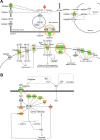Fetal iron deficiency alters the proteome of adult rat hippocampal synaptosomes
- PMID: 24089371
- PMCID: PMC3882566
- DOI: 10.1152/ajpregu.00292.2013
Fetal iron deficiency alters the proteome of adult rat hippocampal synaptosomes
Abstract
Fetal and neonatal iron deficiency results in cognitive impairments in adulthood despite prompt postnatal iron replenishment. To systematically determine whether abnormal expression and localization of proteins that regulate adult synaptic efficacy are involved, we used a quantitative proteomic approach (isobaric tags for relative and absolute quantitation, iTRAQ) and pathway analysis to identify dysregulated proteins in hippocampal synapses of fetal iron deficiency model. Rat pups were made iron deficient (ID) from gestational day 2 through postnatal day (P) 7 by providing pregnant and nursing dams an ID diet (4 ppm Fe) after which they were rescued with an iron-sufficient diet (200 ppm Fe). This paradigm resulted in a 40% loss of brain iron at P15 with complete recovery by P56. Synaptosomes were prepared from hippocampi of the formerly iron-deficient (FID) and always iron-sufficient controls rats at P65 using a sucrose gradient method. Six replicates per group that underwent iTRAQ labeling and LC-MS/MS analysis for protein identification and comparison elucidated 331 differentially expressed proteins. Western analysis was used to confirm findings for selected proteins in the glutamate receptor signaling pathway, which regulates hippocampal synaptic plasticity, a cellular process critical for learning and memory. Bioinformatics were performed using knowledge-based Interactive Pathway Analysis. FID synaptosomes show altered expression of synaptic proteins-mediated cellular signalings, supporting persistent impacts of fetal iron deficiency on synaptic efficacy, which likely cause the cognitive dysfunction and neurobehavioral abnormalities. Importantly, the findings uncover previously unsuspected pathways, including neuronal nitric oxide synthase signaling, identifying additional mechanisms that may contribute to the long-term biobehavioral deficits.
Keywords: glutamate signaling; hippocampal function; iTRAQ; iron; micronutrient deficiency; neuroplasticity; synaptosome.
Figures




Comment in
-
The effect of maternal haematocrit on offspring IQ at 4 and 7 years of age: a secondary analysis.BJOG. 2016 Dec;123(13):2087-2093. doi: 10.1111/1471-0528.14263. Epub 2016 Aug 17. BJOG. 2016. PMID: 27533357
References
-
- Beard J, Erikson KM, Jones BC. Neonatal iron deficiency results in irreversible changes in dopamine function in rats. J Nutr 133: 1174–1179, 2003. - PubMed
-
- Beard JL, Wiesinger JA, Connor JR. Pre- and postweaning iron deficiency alters myelination in Sprague-Dawley rats. Dev Neurosci 25: 308–315, 2003. - PubMed
-
- Ben-Shachar D, Yehuda S, Finberg JP, Spanier I, Youdim MB. Selective alteration in blood-brain barrier and insulin transport in iron-deficient rats. J Neurochem 50: 1434–1437, 1988. - PubMed
Publication types
MeSH terms
Substances
Grants and funding
LinkOut - more resources
Full Text Sources
Other Literature Sources
Research Materials

